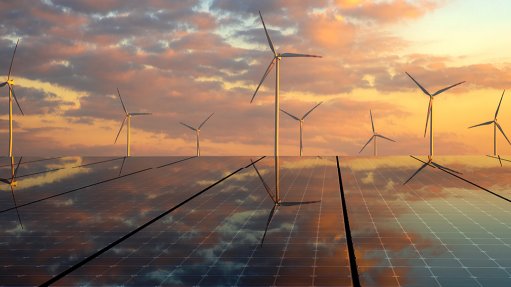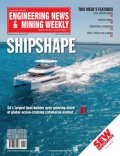Development of Matjiesfontein ground station project moving too fast for Nasa
The development of the South African National Space Agency’s (Sansa’s) new Matjiesfontein ground station, in the Western Cape, is confidently progressing but it might be moving too fast for the US National Aeronautics and Space Administration (Nasa), according to Sansa chief engineer Eugene Avenant.
Nasa is to be Sansa’s primary client at the new station, which will provide mission critical support for the Artemis lunar missions planned for the next few years. The Nasa-led Artemis programme aims to put humans back on the moon.
Avenant said on April 28 that, compared with two other similar facilities being developed in the US and Australia to also support Nasa’s lunar missions, the Matjiesfontein project is fairly advanced.
He revealed that Nasa has, on several occasions asked Sansa to “just cool down a little bit” and to give it more time to assess the proposed infrastructure and equipment so that it can meet Nasa’s requirements and avoid having to be replaced at a later stage.
“We are actually chomping at the bit to get moving but we are being held a little bit back. It's a bit of a push-pull situation right now, because there's some urgency around getting this done. We have funding cycles and we have deadlines that we need to meet.
“So, on the one hand, we are in a hurry. On the other hand, we need to just stay calm and make sure we build the right thing and constantly review specifications to make sure we are moving forward in the right way,” Avenant explained.
He said Sansa has made significant progress on the project, with several studies already completed, such as the environmental-impact assessment.
The site for the new station was officially launched in November last year. Detailed planning for the Matjiesfontein space complex has started and is expected to be completed by the fourth quarter of 2025.
Meanwhile, Sansa has already launched some of the procurement programmes for the site regarding telecommunications and Internet connectivity, as well as power transmission infrastructure.
The agreement with Nasa is that Sansa will establish the core infrastructure and Nasa will establish lunar exploration ground site (Legs) antennae at the site, along with all the related equipment. This will include the development of a new 18 m to 24 m subnet to support the Artemis missions. Sansa will then enter into an operations and maintenance agreement with Nasa.
The site will become a vital part of the near space network, playing a vital role in Artemis launch support from lift-off through to separation. The new launch communications segment will support Artemis’ Orion spacecraft and the space launch system moon rocket.
The site will also be a vital part of the deep space network, with a 34 m subnet providing continuous high-rate command and telemetry to Nasa’s gateway system, human landing system and other Artemis space systems.
The Matjiesfontein facility will be operated and maintained on a 24/7 basis and will also provide infrastructure hosting services for other clients in future. Additional infrastructure will accommodate Nasa’s CubeSat, image downloading, spectrum analysis, monitoring and space weather mission reception.
The new site is also envisioned to include a science centre, which will be open to local communities and tourists. The local community is also expected to benefit from the establishment of the new electricity and communication connections, which are necessary for the ground station to operate as required.
The vision is that, in addition to providing lunar mission support, the Matjiesfontein facility will serve as a hub for universities and industry players to drive innovations in space technologies and research and develop possible applications.
The new site will be aimed at not only providing support for upcoming lunar missions, but will support deep space exploration missions as well, including Mars missions, thereby opening up the possibility for various partnership opportunities with both public and private space industry players globally.
“To Nasa, Artemis is sort of a stepping stone to Mars. So, a lot of the things they're going to be doing in the Artemis missions are really there to prove technologies and understand what it is that is going to be required to get to Mars and beyond,” Avenant said.
The new site will extend Sansa’s capability to provide the necessary infrastructure and technology necessary to communicate with satellites, probes, rockets and terrestrial planets, serving as an extension of the agency’s Hartebeeshoek site, in Gauteng.
The Majtiesfontein site will include a control room and server room, various workshops, an on-site store, guardhouse and information centre, all contained within a 1 km x 1 km fenced off area, with the potential to be expanded as new technologies are developed and diversified.
In addition, the site will also host a photovoltaic solar power station. Avenant said the site would need to be powered through a combination of solar, Eskom-generated power and diesel generators to ensure stable power supply at all times.
“Power is a primary driving concern. We cannot afford to not have power – it is simply not an option. We are, therefore, spending a lot of time developing the power reticulation of the Matjiesfontein site to ensure we can provide the services at the reliability level that Nasa will require from us,” he said.
He pointed out that there have been numerous expressions of interest for Sansa to host other equipment at the site; however, Sansa has to tread carefully to ensure other client infrastructure does not interfere with Nasa as the primary client.
Comments
Press Office
Announcements
What's On
Subscribe to improve your user experience...
Option 1 (equivalent of R125 a month):
Receive a weekly copy of Creamer Media's Engineering News & Mining Weekly magazine
(print copy for those in South Africa and e-magazine for those outside of South Africa)
Receive daily email newsletters
Access to full search results
Access archive of magazine back copies
Access to Projects in Progress
Access to ONE Research Report of your choice in PDF format
Option 2 (equivalent of R375 a month):
All benefits from Option 1
PLUS
Access to Creamer Media's Research Channel Africa for ALL Research Reports, in PDF format, on various industrial and mining sectors
including Electricity; Water; Energy Transition; Hydrogen; Roads, Rail and Ports; Coal; Gold; Platinum; Battery Metals; etc.
Already a subscriber?
Forgotten your password?
Receive weekly copy of Creamer Media's Engineering News & Mining Weekly magazine (print copy for those in South Africa and e-magazine for those outside of South Africa)
➕
Recieve daily email newsletters
➕
Access to full search results
➕
Access archive of magazine back copies
➕
Access to Projects in Progress
➕
Access to ONE Research Report of your choice in PDF format
RESEARCH CHANNEL AFRICA
R4500 (equivalent of R375 a month)
SUBSCRIBEAll benefits from Option 1
➕
Access to Creamer Media's Research Channel Africa for ALL Research Reports on various industrial and mining sectors, in PDF format, including on:
Electricity
➕
Water
➕
Energy Transition
➕
Hydrogen
➕
Roads, Rail and Ports
➕
Coal
➕
Gold
➕
Platinum
➕
Battery Metals
➕
etc.
Receive all benefits from Option 1 or Option 2 delivered to numerous people at your company
➕
Multiple User names and Passwords for simultaneous log-ins
➕
Intranet integration access to all in your organisation


















